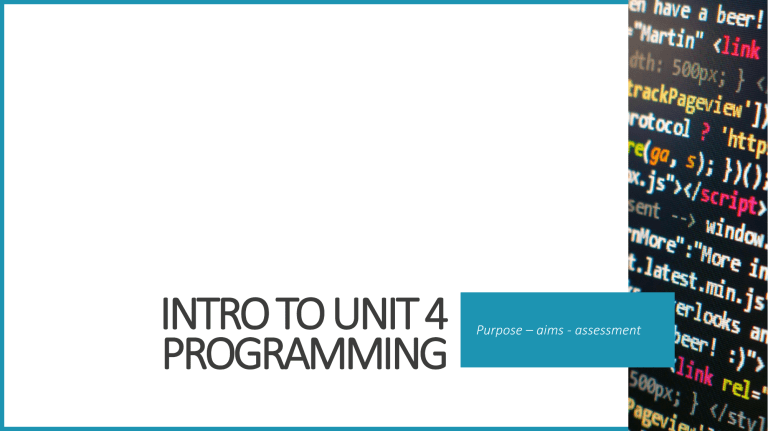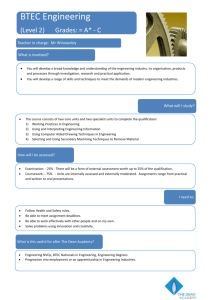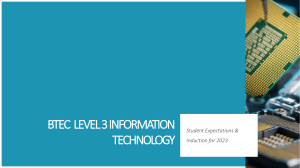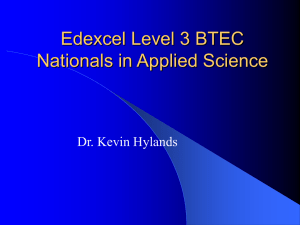
INTRO TO UNIT 4 PROGRAMMING Purpose – aims - assessment UNIT 4 OVERVIEW Outline of the unit • You will study underpinning concepts and implications of programming languages to design, develop and test computer programs. • Develop basic programming skills. • Complete two internal assessments Computing Games & IT 2 UNIT 4 INTRODUCTION Assignment 1 overview • LA.A Examine the computational thinking skills and principles of computer programming Computing Games & IT 3 UNIT 4 INTRODUCTION Assignment 1 overview - LA.A • Learning aim A: Examine the computational thinking skills and principles of computer programming • A1 Computational thinking skills • • • • Decomposition Pattern recognition Pattern generalisations and abstraction Representing parts of a problem or system • A2 Uses of software applications • The uses and implications of software applications in solving problems and fulfilling needs. • A3 Features and characteristics of programming languages • • The uses and applications of different types of high and low-level programming languages and develop to assist in the solution of particular problems Factors to compare and contrast in programming languages Computing Games & IT 4 UNIT 4 INTRODUCTION Assignment 1 overview - LA.A • A4 Constructs and techniques and their implementation in different languages • Programming languages, constructs and techniques • A5 Principles of logic applied to program design • A6 Quality of software applications • How the design and implementation of a software application affects quality Computing Games & IT 5 UNIT 4 INTRODUCTION Assignment 2 overview - LA.B and LA.C • LA. B Design a software solution to meet client requirements • LA. C Develop a software solution to meet client requirements. Computing Games & IT 6 UNIT 4 INTRODUCTION Assignment 2 overview - LA.B and LA.C Learning aim B: • Design a software solution to meet client requirements B1 Software development life cycle • Application of the software development life-cycle stages • B2 Software solutions design Computing Games & IT 7 UNIT 4 INTRODUCTION Assignment 2 overview - LA.B and LA.C Learning aim C: • Develop a software solution to meet client requirements C1 Software solutions development • The process of software development • C2 Testing software solutions • Testing of the programs • C3 Improvement, refinement and optimisation of software applications • Methods of improving, refining and optimising • C4 Review of software solutions • Evaluation of software solutions • C5 Skills, knowledge and behaviours Computing Games & IT 8 Unit 4 Criteria Computing Games & IT 9 UNIT 4 INTRODUCTION qualification codes You are enrolled on one of the following courses over two years: • Pearson BTEC Level 3 National Extended Certificate in Information Technology (360 GLH) 601/7575/8 (1 A level Equivalent) • Pearson BTEC Level 3 National Diploma in Information Technology (720 GLH) 603/0455/8 Pearson BTEC L (2 A level Equivalent) • Pearson BTEC Level 3 National Extended Diploma in Information Technology (1080 GLH) 603/0454/6. (3 A level Equivalent) Computing Games & IT 10 UNIT 4 INTRODUCTION – COURSE OVERVIEW Pearson BTEC Level 3 National Extended Certificate in Information Technology (360 GLH) 601/7575/8 (1 A level Equivalent) • Comprises of 4 units • 3 are mandatory and 2 are external. • Mandatory content (83%). • External assessment (58%). • This qualification is designed for learners who are interested in an introduction to the study of creating IT systems to manage and share information, alongside other fields of study, with a view to progressing to a wide range of higher education courses, not necessarily in IT. Computing Games & IT 11 UNIT 4 INTRODUCTION - COURSE OVERVIEW Pearson BTEC Level 3 National Diploma in Information Technology (720 GLH) 603/0455/8 Pearson BTEC L (2 A level Equivalent) • Comprises of 8 units • 6 are mandatory and 3 are external. • Mandatory content (83%). • External assessment (46%). • The qualification is designed to be studied over two years and carries UCAS tariff points. It meets entry requirements in its own right for some courses in IT or related study such as an HNC or HND in Computing, Engineering or Business Management. For progression to a degree course, learners should normally study this qualification alongside other qualifications, such as an A Level or BTEC Extended Certificate in a different or complementary subject area. Computing Games & IT 12 UNIT 4 INTRODUCTION – COURSE OVERVIEW Pearson BTEC Level 3 National Extended Diploma in Information Technology (1080 GLH) 603/0454/6. (3 A level Equivalent) • Comprises of 13 units • 7 are mandatory and 4 are external. • Mandatory content (67%). External assessment (42%). • The qualification is designed to be studied over two years and carries UCAS tariff points. It fully meets entry requirements for progression to a degree course in IT and related areas such as: digital technology solutions, IT management for business, computer networks security or business computing and entrepreneurship. Computing Games & IT 13 Course Unit Structure Computing Games & IT 14 UNIT 4 INTRODUCTION Developing good practice • Take notes! You can't remember everything! • What is the name of the course you are studying? • How many A levels is it equivalent to? Computing Games & IT 15 UNIT 4 INTRODUCTION – COURSE OVERVIEW Grading for units and qualifications • Units are assessed using a grading scale of: • • • • • Distinction (D) Merit (M) Pass (P) Near Pass (N) and Unclassified (U). • The grade of Near Pass is used for externallyassessed units only. • Unit 3 is a 90 GLH will contribute 1.5 times that of a 60 GLH unit. • Qualifications in the suite are graded using a scale of: • • • P to D* or PP to D*D* or PPP to D*D*D*. • All mandatory and optional units contribute proportionately to the overall qualification grade. Computing Games & IT 16 UNIT 4 Calculation of qualification grade Computing Games & IT 17 UNIT 4 INTRODUCTION Points available Computing Games & IT 18 UNIT 4 INTRODUCTION Eligibility for an award • In order to be awarded a qualification: • a learner must complete all units, • achieve a Near Pass (N) or above in all external units, • Achieve a pass or above in all mandatory units. • achieve the minimum number of points at a grade threshold. • for the Extended Diploma achieve a minimum 900 GLH at Pass or above (or N or above in external units) Computing Games & IT 19 UNIT 4 INTRODUCTION Eligibility for an award • In order to be awarded a qualification: • Achieve a pass or above in all mandatory units. • achieve the minimum number of points at a grade threshold. THEREFORE, YOU MUST ACHIEVE A PASS OR ABOVE IN UNIT 4 Computing Games & IT 20 UNIT 4 INTRODUCTION Get to know your Unit • Explore the Learning Resource area on Moodle • Familiarise yourself with your assessment paper • Organise your working area – one drive • Remember to take notes in class! • Questions? Computing Games & IT 21





